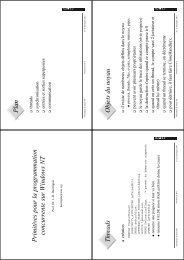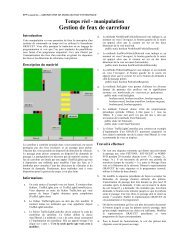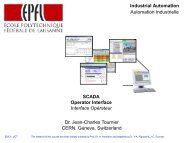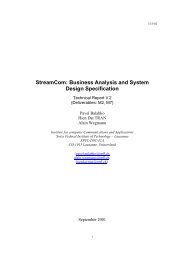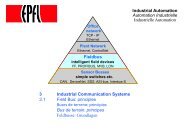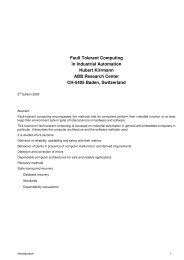REAL-TIME SYSTEMS II Real-Time Networking WorldFIP ... - EPFL
REAL-TIME SYSTEMS II Real-Time Networking WorldFIP ... - EPFL
REAL-TIME SYSTEMS II Real-Time Networking WorldFIP ... - EPFL
Create successful ePaper yourself
Turn your PDF publications into a flip-book with our unique Google optimized e-Paper software.
Basic Choices<br />
Basic Choices (2)<br />
<strong>Real</strong>-<strong>Time</strong> Networks – <strong>WorldFIP</strong> 5<br />
• <strong>Real</strong>-time traffic consists of state information transferred in a<br />
cyclic or periodic manner but not event transmission<br />
• All information is broadcast<br />
• For real-time traffic,<br />
• only variables are identified (identifiers). Network nodes or application<br />
processes are not identified<br />
• the communication model is the Producer-Distributor-Consumer (PDC)<br />
Model where variable values transferred on the network are neither<br />
queued at production nor at reception<br />
• There is no retransmission and no acknowledge for real-time traffic<br />
• Consumers are responsible for checking transmission status and taking<br />
appropriate actions when problems arise<br />
©2010, J.-D. Decotignie<br />
<strong>Real</strong>-<strong>Time</strong> Networks – <strong>WorldFIP</strong> 6<br />
• All variables transferred in real-time and their characteristics<br />
(period, relation with other transfers) are known in advance<br />
• MAC handled by a unique active distributor. Backup allowed<br />
• The response time is bounded between 10 and 70 bit times.<br />
• Transfers are either periodic or sporadic.<br />
• The transfer period for the values corresponding to a variable may differ<br />
from the period associated to another variable. The only restriction is that<br />
periods should be integer multiples of a basic period.<br />
• Mechanisms to indicate temporal validity as well as temporal<br />
and spatial consistency of variable values built in the protocol.<br />
• The non real-time traffic handled using the conventional clientserver<br />
model and the corresponding application is a subset of<br />
MMS (Manufacturing Message Specification).<br />
©2010, J.-D. Decotignie<br />
Physical layer<br />
Coding<br />
<strong>Real</strong>-<strong>Time</strong> Networks – <strong>WorldFIP</strong> 7<br />
• twisted pairs (C46-604), optical fibers (C46-607)<br />
• 3 speed classes<br />
• S1 (31.25 Kbits/s) / S2 (1 Mbits/s) / S3 (2.5 Mbits/s)<br />
• Number of elements and range limited by<br />
• Propagation time Tp<br />
• normal case: Tp < 20 Tbit / extended: Tp < 40 Tbit<br />
• Losses and distortion on the cable<br />
• 3 conformance classes<br />
• CH: high level class, allows long distance transmission at high data rates<br />
• CM: medium power class<br />
• CL: low power class for application with intrinsic safety requirements.<br />
• recommended speeds<br />
• S1 or S2 for CL, S2 for CM, S2 or S3 for CH<br />
©2010, J.-D. Decotignie<br />
<strong>Real</strong>-<strong>Time</strong> Networks – <strong>WorldFIP</strong> 8<br />
• balanced (bipolar) transmission<br />
• MANCHESTER encoding<br />
-T/2<br />
H<br />
T/2 -T/2<br />
B<br />
T/2<br />
H<br />
-T/2 T/2<br />
-T/2 T/2<br />
B<br />
-T/2<br />
H<br />
T/2 -T/2<br />
1 0 V+ V- EB+ EB-<br />
Data Violations equalization bits<br />
B<br />
T/2<br />
©2010, J.-D. Decotignie



